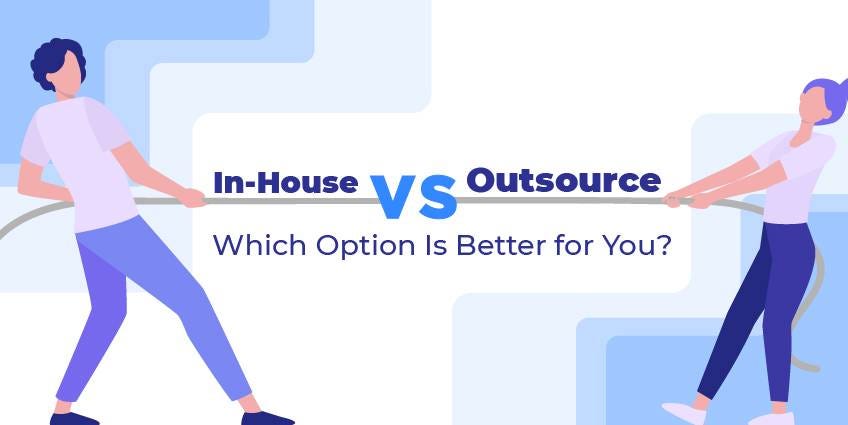In-House vs. Outsourced Marketing: How to Choose the Right Strategy for Your Brand’s Growth (The Great Marketing Dilemma)

In today’s dynamic business environment, one of the most crucial decisions companies face is whether to build an in-house marketing team or outsource their marketing efforts. This choice can significantly impact a brand’s growth, customer engagement, and overall market positioning. But how do you decide which route is best for your company?
If you’re not strategically managing your marketing outreach, you’re likely missing out on valuable opportunities. The debate between in-house and outsourced marketing is more relevant than ever. Discover the best approach for your brand and ensure you’re making the most out of your marketing investments!
Understanding In-House Marketing: The Pros and Cons
Pros:
- Deep Brand Knowledge: An in-house team is fully immersed in your company’s culture, values, and vision. This immersion ensures that all marketing efforts are consistent with your brand’s voice and message. For example, Nike’s in-house team has a deep understanding of the brand’s ethos, allowing them to create campaigns that resonate deeply with their target audience.
- Immediate Collaboration and Agility: Proximity fosters better communication and faster decision-making. In-house teams can quickly adapt to changes, address issues, and implement strategies. For instance, when a sudden PR issue arises, in-house teams like those at Starbucks can respond swiftly, maintaining brand integrity and customer trust.
- Cost Efficiency Over Time: While the initial investment in building an in-house team can be high, it often proves cost-effective in the long run, especially for companies with continuous and extensive marketing needs. HubSpot, for instance, has effectively managed to balance in-house and outsourced resources, optimizing costs and maximizing output.
Cons:
- Limited Expertise and Fresh Perspectives: In-house teams may lack the breadth of expertise and diverse perspectives that specialized agencies bring. This can lead to a creative stagnation or missed opportunities. Spotify, recognizing this, frequently collaborates with external agencies to inject fresh ideas and perspectives into their campaigns.
- Scalability Constraints: Scaling an in-house team to meet growing demands can be challenging. The process of hiring, training, and retaining talent can be time-consuming and costly, limiting the company’s ability to scale quickly. For instance, a company like LinkedIn, with rapidly evolving needs, might find it challenging to scale its in-house team quickly enough.
- Potential for Burnout: Working exclusively on a single brand can lead to creative fatigue. Adobe combats this by periodically rotating team members’ responsibilities and encouraging cross-departmental collaborations to keep ideas fresh and engaging.

The Case for Outsourced Marketing: The Pros and Cons
Pros:
- Access to Specialized Skills and Expertise: Outsourcing provides access to a wide range of specialized skills and expertise that might be hard to cultivate in-house. For example, Coca-Cola often partners with top creative agencies like Ogilvy to leverage their unique expertise in global campaign execution and storytelling.
- Scalability and Flexibility: Agencies offer the flexibility to scale up or down based on your specific needs and budget. This is particularly beneficial for startups or companies experiencing rapid growth. Dropbox, for instance, used outsourced marketing agencies during its early years to rapidly scale its user acquisition efforts.
- Cost-Effectiveness: Outsourcing can be more cost-effective than maintaining a full in-house team, especially for specific projects or short-term campaigns. Airbnb has effectively used outsourced creative agencies for targeted campaigns, optimizing their marketing spend while achieving high-impact results.
Cons:
- Limited Brand Intimacy: External teams may not fully grasp your brand’s unique nuances, potentially leading to misaligned messaging. For example, a misstep by an agency in understanding Pepsi’s brand ethos led to a controversial advertisement, highlighting the importance of brand intimacy.
- Communication Challenges: Outsourced teams may not be as accessible, leading to potential delays and misunderstandings. Effective communication and clear briefs are crucial to mitigate this risk. Unilever, with its vast portfolio of brands, ensures regular communication and feedback loops with its agency partners to maintain alignment.
- Loss of Control: Outsourcing involves sharing control over the creative process and decision-making, which can be uncomfortable for some companies. Apple, known for its tight control over brand messaging, primarily relies on its in-house team for core marketing functions while outsourcing selective creative projects.
Crunching the Numbers: A Statistical Overview
- Cost Comparison: According to a study by Deloitte, 62% of companies outsource some or all of their marketing functions. The average cost to hire an in-house marketing manager in the U.S. is around $70,000 annually, excluding benefits. In contrast, outsourcing costs can range from $2,000 to $20,000 per month, depending on the scope of services and the agency’s expertise.
- Performance Metrics: A report by HubSpot found that companies with outsourced marketing teams see a 30% higher ROI on average compared to those with solely in-house teams. This is attributed to the diverse expertise and advanced tools agencies bring.
- Scalability: A survey by Clutch revealed that 68% of businesses experienced faster scaling and adaptation to market changes when working with outsourced teams compared to solely relying on in-house resources.
Practical Examples and Applications
- Tech Giants and Hybrid Approaches: Companies like Google and Microsoft utilize a hybrid model, combining the strengths of both in-house and outsourced teams. This approach allows them to maintain control over core brand messaging while leveraging external expertise for specialized campaigns or market-specific strategies.
- Retail and Consumer Goods: Procter & Gamble (P&G) often collaborates with multiple agencies for its vast range of products. By doing so, P&G ensures each brand’s marketing strategy is tailored to its specific audience while maintaining overall brand consistency.
- Financial Services: American Express uses a mix of in-house and outsourced teams to manage its global marketing efforts. This blend allows for deep understanding and control over sensitive financial services while tapping into the creative prowess of agencies for consumer-focused campaigns.
Making the Choice: A Practical Guide
- Assess Your Specific Needs: Evaluate your company’s current marketing capabilities, goals, and budget. Do you need comprehensive strategic planning, or are you looking for specific skills like SEO or content creation?
- Analyze Cost vs. Benefit: Conduct a detailed cost analysis, factoring in both the direct and indirect costs of in-house and outsourced marketing. Consider long-term benefits and potential ROI.
- Determine the Level of Control Required: Decide how much control and oversight you need over your marketing efforts. This will help determine if a more integrated in-house approach or a flexible outsourced model suits your needs.
- Consider Future Growth and Scalability: Think about your company’s growth trajectory and whether your marketing needs might change in the near future. Can your current team scale, or will you need additional resources?
- Evaluate the Need for Specialized Expertise: If your marketing strategy requires specialized skills or creative innovation, an agency might provide the necessary expertise and fresh perspectives.
Final Thoughts: The Verdict
The decision between in-house and outsourced marketing isn’t straightforward. It requires careful consideration of your company’s unique needs, goals, budget, and growth potential. Both options offer distinct advantages and challenges. For some, a hybrid approach, combining the strengths of both, might be the best solution.
Don’t miss out on optimizing your marketing strategy. Evaluate your options, align them with your business objectives, and choose the path that promises the best return on your marketing investment. Your brand’s future depends on making the right choice today!
Ready to Make the Call?
With these insights, you’re now equipped to make an informed decision about your marketing strategy. Whether you choose in-house, outsourced, or a hybrid approach, the key is to align your strategy with your brand’s vision and growth objectives. Remember, the right choice can propel your brand forward, ensuring sustained growth and market leadership.
Join the discussion and share your thoughts

Comments
Post a Comment